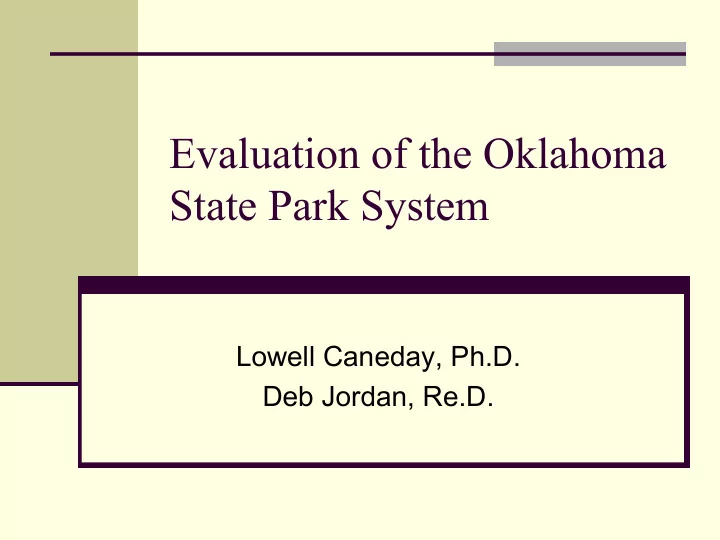

Evaluation of the Oklahoma State Park System Lowell Caneday, Ph.D. Deb Jordan, Re.D.
Research Team n Oklahoma State University, Leisure Studies n Dr. Lowell Caneday, Dr. Deb Jordan, Dr. Yating Liang n Nathan Caneday, Kaowen Chang, Bullit Farris n Oklahoma State University, Bureau of Social Research n Dr. Christine Johnson and staff members n Dornbusch Associates n Jason Bass and David Dornbusch
Project Overview n Phase 1 – Inventory of outdoor recreation resources and GIS mapping n Phase 2 – Statewide recreation needs assessment n Phase 3 – Benchmarking the state park system n Phase 4 – Reporting n Extension – Carrying capacity of dune parks
Phase 1 – Inventory and Mapping n Geographic Information Systems n Map Layers n Political boundaries n Highways n Bodies of water n Land ownership
Phase 2 – Needs Assessment n Telephone survey – 2,013 completed calls n On-line survey – 651 respondents n Focus groups – 8 held statewide n Oklahoma City, Tulsa, Woodward, Miami, Weatherford, Lawton, Beavers Bend, Tahlequah n State Park visitor study – 3,414 respondents n State Park managers’ study – 350 staff respondents
General Conclusions n Oklahoma population is better educated and more diverse than are actual state park visitors n Racial, ethnic differences exist among park visitors n 50% of Oklahomans report having visited a state park in past 12 months n Confused as to which properties are state parks n Large majority of park visitors are day users n Park visitors ‘self-select’ preferred parks n State parks are a ‘public trust’
General Conclusions n Primary purpose of state parks: provide inexpensive outdoor recreation opportunities n Differing views among campers, cabin guests, and lodge guests n Differing views among general population and park visitors n Strong views on economic value of parks n Unwilling to pay more taxes n Perception that parks, lodges, golf course are profitable n Great value to local economies
Phase 3 – Benchmarking n Plan – determine what to benchmark n 8 performance measures Improve Plan n Plan – identify benchmarking partners n 6 state park systems n Do – data collection n Check – data analysis Check Do n Improve - implementation
Identify Benchmarking Partners n Similar versus dissimilar partners n Mutual assistance (both partners must benefit) n What is ‘best in class’? n Who is ‘best in class’ on specific measures? n Who do we want to be like?
FL, IL, MI, MO, OR, CA TX, WA NY AK, AZ AR, CT, DE, AL, GA, IN, KY, HI, KS, LA, ME, OH, OK, SD, TN, MA, MN, MS, NE, NASPD WV NV, NJ, NM, NC, PA, RI, SC, UT, VT, VA, WI, WY CO, ID, MT, IA, MD NH, ND
Benchmarking Partners n Similar to Oklahoma n Dissimilar from State Parks Oklahoma State Parks n Indiana, Georgia n Arkansas, Missouri, Colorado, North Carolina Defining factors: 40 measures of operations Operating budget, capital budget, personnel, funding sources, acreage, types of property, amenities NOT agency of management or mission statement
General Conclusions n Financial support n Oklahoma lowest on capital expenditure n 3 rd highest in operating budget n Used fewer funding vehicles for revenue n 3 rd highest in total visitor revenue n Concessionaires n 4 systems dominated by state owned facilities, Oklahoma and Arkansas differed from that n 4 systems annually evaluate quality
General Conclusions n Marketing and public information n Marketing materials, Web pages n Only Georgia and Arkansas reported marketing plans n Oklahoma conducted fewer customer surveys n Oklahoma had fewest park interpretive staff n Maintenance n Oklahoma 5 th in acreage, 3 rd in average budget per acre n Four partners applied national standards n Partners spend greater percentage on upkeep
General Conclusions n Planning n Only Oklahoma did NOT have master plan n Partners have business plans, capital improvement plans, staffing plans, and interpretive plans for EACH property n Public Involvement/Constituent Understanding n Similar patterns among all partners n Three systems, including Oklahoma, have non- profit foundations
General Conclusions n Staffing and Personnel n Fewer interpreters than all but North Carolina n 2 nd highest number of employees (behind Georgia) n High ratio of visitors to staff n Stewardship n OK only system without ROS, LAC, VERP, and carrying capacity models n Varied from partners on factors in development (Politics #1)
Recommendations: Philosophy n Establish and publicize the meaning of Oklahoma State Parks n Manage that system utilizing a Recreation Opportunity Spectrum (ROS) n Develop a green plan for operations
Recommendations: Assess Needs n Agency and staff awareness of constituents n Formalize public input related to planning and operations
Recommendations: Program Plan n Plan for amenities fitting intent in each park n Develop and implement a park-preparedness process and plan n Establish and implement a maintenance plan applying professional standards n Develop a resource management plan for each property n Thorough review of existing policies and procedures n Require concessionaires to comply with performance objectives and quality standards
Recommendations: Pre-program n Refine marketing efforts – target specific groups and types of users n Initiate a dedicated funding source – vehicle license surcharge n Increase capital investment to rehabilitate and repair existing infrastructure n Reconsider the role of interpretation and education n Develop a compelling message for the public
Recommendations: Personnel n Establish and implement a professional development school for staff
Extension of Project n Carrying capacity at Little Sahara and Beaver Dunes n Utilizing the Visitor Experience and Resource Protection (VERP) model n By August 2005
Recommend
More recommend